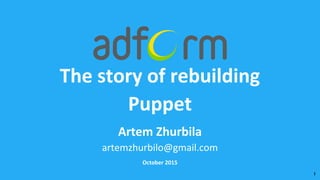Artem zhurbila the story of rebuilding puppet (devops meetup 29.10.2015)
- 1. The story of rebuilding Puppet October 2015 1 Artem Zhurbila artemzhurbilo@gmail.com
- 2. 2 2013 ... Old Puppet infra New Puppet infra June 2015 May 2015 Joins Adform
- 3. Why new puppet infra? 3
- 4. Old Puppet infra New Puppet infra One giant repository with all modules One core repository (puppet-control) + independant modules Public modules are downloaded once and never updated Modules and theirs versions are controled in Puppetfile Code duplication Profiles / Roles pattern encourage to reuse modules No consistent style Lint, style checking is enforced No possibility to test puppet manifests locally Vagrant box can be used to run and provision VMs easily on a local machine No unit tests Unit tests are supported (rake spec) No acceptance tests Acceptance tests are supported (rake acceptance) No clear branching model All new development starts by feature-branching which is merged only after code review No visibility Puppet Explorer dashboard show status of all nodes 4
- 5. Puppet 4 bonuses ŌØÅ Puppet Server -> clojure (JVM) ŌØÅ Environments approach by default ŌØÅ More clear naming rules ŌØÅ New language features ŌØÅ Functions (each, map, filter, map, reduce) ŌØÅ Types (Integer, Boolean, Enum, Collection, etc) 5
- 9. CI pipeline .gitlab-ci.yml localtest: script: - rake localtest check-Puppetfile: script: - ruby -c Puppetfile 9 task :localtest => [ :syntax, :lint, :yamllint, :jsonlint, :metadata, ]
- 12. Puppetfile 12 #!/usr/bin/env ruby #^syntax detection forge "https://forgeapi.puppetlabs.com" # A module from the Puppet Forge mod 'puppetlabs/stdlib', '4.6.0' mod 'puppetlabs/java', '1.4.1' mod 'cyberious/windows_java', '1.0.2' mod 'puppetlabs/concat', '1.2.3' mod 'stahnma/epel', '1.0.2' mod 'puppetlabs/firewall', '1.6.0' mod 'puppetlabs/ntp', '4.1.0' ... ...
- 13. Modules deploy 13 Advantage: Optimized caching Disadvantage: No dependency resolution
- 15. env VS tier branch == environment tier == [dev | preprod | prod | infra] main branch is the master (trunk) branch which should always be in a stable state! production branch is a default Puppet environment and itŌĆÖs used only for initial Puppet agent bootstrap. 15
- 16. Profiles / Roles pattern 16
- 17. Profiles / Roles pattern 17
- 18. Profiles / Roles pattern 1 node includes 1 role 1 role includes >= 1 profiles 18
- 19. Hieradata 19
- 20. hiera.yaml 20 ... :hierarchy: - "nodes/%{::fqdn}" - "tiers/%{::tier}/host_group/%{hostname_group}" - "tiers/%{::tier}/%{calling_class_path}" - "tiers/%{::tier}/common" - "default/host_group/%{hostname_group}" - "default/%{calling_class_path}" - "default/common" ...
- 21. Hiera data ŌĆó Separate data from logic: move data to Hiera as much as possible ŌĆó Attribute names should match your puppet class name. E.g for 'profiles::elk::server' class, all attributes in hiera should start with 'profiles::elk::server:: [ATTRIBUTE_NAME]' 21
- 24. Maintenance mode #puppet agent --disable 'FOOBAR maintenance for 6hrs; contact @it.solution for any reason' Puppet Explorer dashboard has a cell which shows node count, which havenŌĆÖt reported in last 24 hours 24
- 25. Puppet NOOP (dry-run) mode 25
- 26. NOOP NOOP is enabled only in PROD env by default $ puppet agent -t --no-noop. This will run Puppet agent with disabled noop mode and actually do the changes 26
- 27. The big picture - Puppet 27
- 28. 28
- 29. Recap: - Focus on testing code changes early and often - Reusing as much as we can 29
- 30. 30








![CI pipeline
.gitlab-ci.yml
localtest:
script:
- rake localtest
check-Puppetfile:
script:
- ruby -c Puppetfile
9
task :localtest => [
:syntax,
:lint,
:yamllint,
:jsonlint,
:metadata,
]](https://image.slidesharecdn.com/artemzhurbila-thestoryofrebuildingpuppetdevopsmeetup29-151029213336-lva1-app6892/85/Artem-zhurbila-the-story-of-rebuilding-puppet-devops-meetup-29-10-2015-9-320.jpg)





![env VS tier
branch == environment
tier == [dev | preprod | prod | infra]
main branch is the master (trunk) branch which should always be in a stable state!
production branch is a default Puppet environment and itŌĆÖs used only for initial Puppet agent
bootstrap.
15](https://image.slidesharecdn.com/artemzhurbila-thestoryofrebuildingpuppetdevopsmeetup29-151029213336-lva1-app6892/85/Artem-zhurbila-the-story-of-rebuilding-puppet-devops-meetup-29-10-2015-15-320.jpg)





![Hiera data
ŌĆó Separate data from logic: move data to Hiera as much as
possible
ŌĆó Attribute names should match your puppet class name.
E.g for 'profiles::elk::server' class, all attributes in hiera
should start with 'profiles::elk::server::
[ATTRIBUTE_NAME]'
21](https://image.slidesharecdn.com/artemzhurbila-thestoryofrebuildingpuppetdevopsmeetup29-151029213336-lva1-app6892/85/Artem-zhurbila-the-story-of-rebuilding-puppet-devops-meetup-29-10-2015-21-320.jpg)








